QAYG Applique pillow covers are easy, fast and fun any holiday.
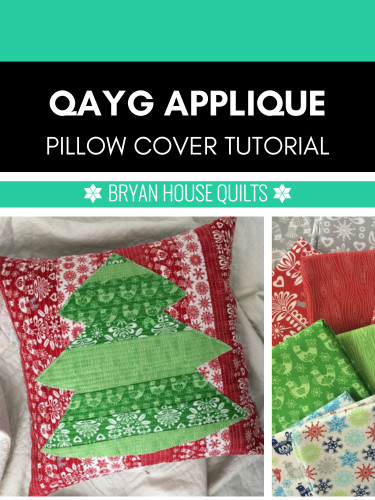
Learn to make this charming pillow using the Quilt As You Go (QAYG) method. Last-minute gift makers, it’s your time to shine!
- Step-by-step instructions with photos and instructions.
- Perfect for using up fabric scraps and batting remnants.
- Get creative and use other motifs like snowflake or candy cane.
- A great tutorial for beginner quilters and kids learning to quilt.
QAYG and Applique Basics
The Quilt As You Go (QAYG) method is a way to piece and quilt at the same time. Instead of quilting the entire quilt top at the end, individual blocks and sections are stitched, then sewn together. The pillow background is layered with batting and backing, then each piece is added and stitched down through the layers.
Applique, on the other hand, involves layering a smaller piece of fabric onto a larger one to create a design. Combining QAYG with applique opens up a world of creative possibilities, allowing you to add designs and personalize your quilts. I made the tree shape from a piece of QAYG fabric, a unique twist that used up my scrappies.

Introducing the Echo Block of the Month, an all NEW design for 2025! Colors and shapes create beautiful symmetry in this modern triangle quilt design. Make Echo or any of our BOM quilts in Make Modern Triangles Club.
Why You Will Love QAYG Applique
Quilt as You Go (QAYG) is a creative way to approach quilting and a favorite method of mine.
- Great for beginners – simplifies the quilting process.
- Manageable way to add stitching to the tops of blocks, especially if you are new to straight line quilting or free motion stitching. The easiest option – stitch in the ditch – is another way to finish the block.
- No heavy lifting. With this method, you work on smaller individual blocks that are later assembled into the final QAYG top.
- By utilizing the QAYG method, quilters can experiment with different designs and improvise with colors and prints.
Supplies
To embark on this festive project, you’ll need the following supplies and tools:
- Sewing Machine: A basic sewing machine with a straight stitch and a walking foot is recommended for quilting.
- Fabric: Choose festive cotton fabrics in red, green, and white for the Christmas tree applique and pillow cover. Or opt for a non-traditional palette. Turquoise and cherry red?
- Batting: Cotton batting provides the perfect amount of loft and warmth to your pillow cover.
- Cutting Tools: Sharp fabric scissors, a rotary cutter, and a cutting mat will help achieve accurate cuts.
- Marking Tools: A fabric pen or pencil, along with a ruler, is essential for marking your fabric for cutting and applique placement.
- Other Supplies: Sewing pins, a seam ripper, an iron, and an ironing board are essential for sewing.
- Thread: Wind your bobbin with the same thread used in the spool for the top thread.
Additionally, a walking foot is the best tool for keeping fabric layers from shifting when quilting. It’s a valuable investment if you plan on tackling more quilting projects in the future.
Materials
To make one pillow cover you will need:
- 2 squares of batting at least 17” (or at least 1” larger than your pillow form). I use Warm and White low loft batting
- 4 Fat Quarters (or 1/4 yard cuts) red fabrics
- 3 Fat Quarters (or 1/4 yard cuts) green fabrics
- 1/2 yard to make the backside envelope
- 1 pillow form, 16” square

Step-by-Step Guide to Creating Your QAYG Applique Pillow Cover
Now, let’s move on to the fun part – creating your QAYG applique pillow cover.
Step 1: Cutting and Preparing Your Fabric
Red and green fabrics: Cut strips of fabric varying in width 1 1/2” to 3 1/2”, such as 1 1/2” strip, a 2 1/2” strip, and a 3 1/2” strip. (Note: if you cut from 1/4 yard cuts, sub cut the strips in half. They should be around 20” in length.)
Backing fabric: Cut two (2) pieces 16 ½ by 19 inches.
Step 2: Sewing the Top Cover and Applique Fabric
Place a green strip right side up along the center of one batting square. Use your walking foot to sew several vertical straight lines of stitching along the strip. When quilting, I increased my stitch length to 3.5. My quilting lines are roughly 1/4” apart.

Option: Add a piece of backing fabric to the back of the batting, which creates a sturdier top. This method is used when the backing will be seen. It creates a QAYG sandwich.
Next, place a second green strip on top of the quilted strip so that right sides are together (second strip is wrong side facing up) and align the raw edges. Use a 1/4” seam allowance, sew the strips together. Note: you will be sewing through the batting too.
Then flip and press the second strip to the side so the right side is facing up. Quilt the second strip as desired. I chose to continue the same straight line quilting.

Each strip is quilted individually. You can use straight-line quilting, free motion quilting, or a combination of both. Be sure to backstitch at the beginning and end of each stitching line to lock your stitches in place.
Repeat Step 2 to finish adding green strips to the batting square.
Make a second QAYG blocks panel in red by repeating the process. Then square (trim) the background (mine is the red) square to 16 ½ inches.

Step 3: Designing and Applying the Christmas Tree Applique
Now comes the fun part – bringing your QAYG applique tree to life! Now, you will cut a shape from one of the panels to applique onto the second panel. I chose to cut out a tree shape from my green panel to applique onto the red panel.
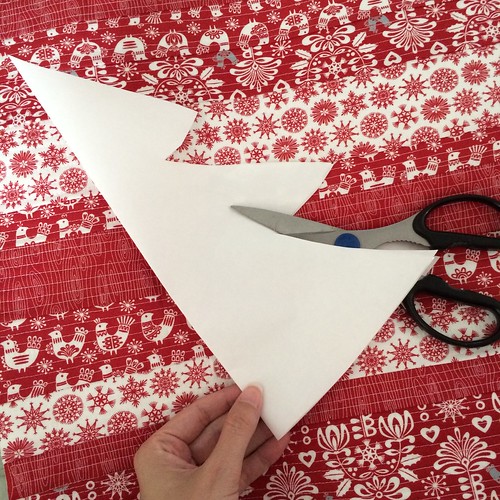
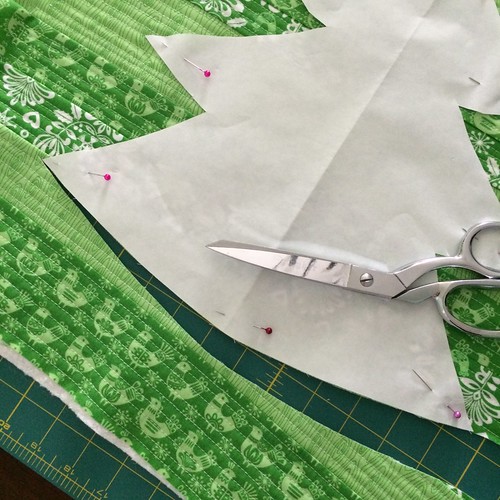
I used the red panel to gauge how large I want my green fabric tree – it should fit on the red panel with at least one inch allowance on the sides. Using freezer paper or copy paper, trace and cut your desired shape. Now pin the paper applique shape on top of the red panel and trace for positioning.
You can also trace the tree pattern using a washable fabric pen directly onto the green fabric and cut out.
Some things to think about as you place your pattern:
- Which way do you want the quilting or pieces to be oriented?
- Make sure that tiny pieces aren’t along the edges of the top cover.
Arrange your tree fabric cut out on the quilted base, ensuring it’s centered and positioned as you desire. If you’re using multiple pieces for the tree, such as a trunk or star, layer them accordingly.
Baste the green pattern piece to the red panel with pins or a few large stitches.
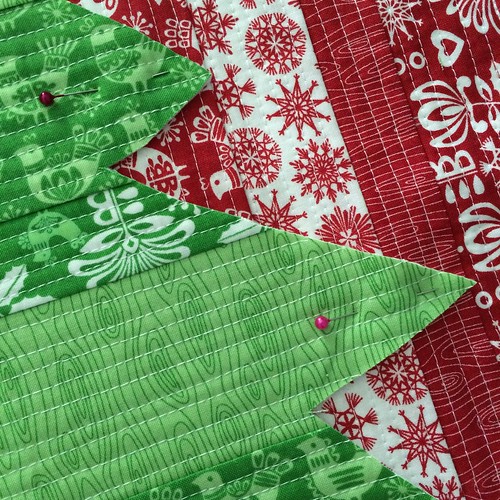
Things to think about:
- How do you want your background quilting and strips oriented? Matching, perpendicular, horizontal or vertical? I oriented mine so that the quilting is perpendicular.
Attach the applique: Use a simple straight stitch or a decorative machine or hand stitch. Sew slowly and carefully around the edges of your applique, making sure to catch all layers of fabric. If you’re using a smaller stitch, consider using a stabilizer on the backside to prevent puckering. I used a blanket stitch and loved it.

Feel free to embellish your Christmas tree further. Add buttons for ornaments, stitch on beads for shimmer, or use embroidery floss for textured effect.
Step 4: Assemble the Pillow Cover and Backing
Make the back envelope pieces by pressing one of the raw edges under by 1/2”. Fold it under again by 1/2” and press. Then top stitch to secure. Do this to both halves.
Lay out the pillow top, right side up. Then lay one side of the envelope back right side down on top of the pillow top. Align the raw edges with the raw edges of the pillow.

Lay the second half of the envelope back right side down and aligning the raw edges to the other side of the pillow top.
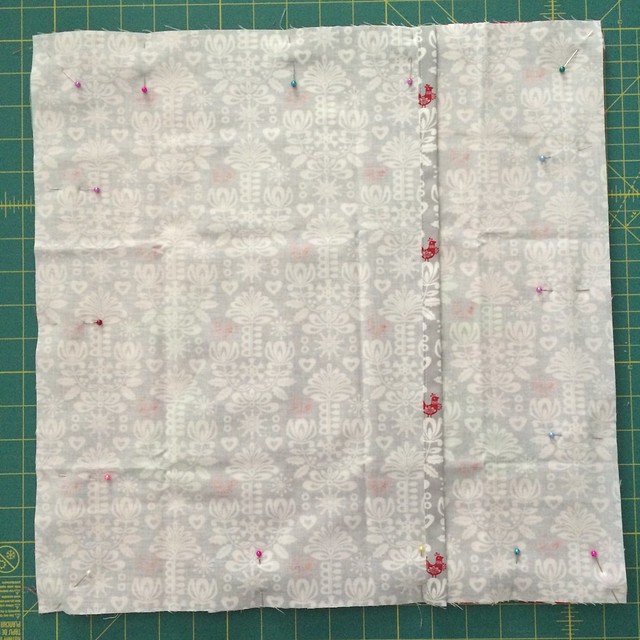
Pin baste around the outer edges.
Sew around the perimeter using a 1/4” seam allowance. Backstitch when starting and stopping and also backstitch when stitching over where the backing pieces overlap, for extra security.
Clip the corners to reduce bulk and turn the pillow right side out. Then shove (daintily mind you!) on a pillow form.
Use a chopstick or a turning tool to gently push out the corners for a crisp finish. Press the seams flat.
TA DA!
Quilting a Quilt the QAYG Applique Way
Are you thinking what I’m thinking? This technique is so versatile – bunnies, Easter eggs, pumpkins and shamrocks! And letters, puppy dogs and birds….go with it!
Frequently Asked Questions
How do I choose the right batting for my pillow cover?
Cotton batting is an excellent choice for pillow covers as it offers a good balance of warmth and sturdiness. You can also opt for other types of batting, such as polyester or bamboo, depending on the desired thickness and warmth.
What’s the best stitch to use for applique edges?
A straight stitch or a zigzag stitch set to a narrow width are standard choices for applique. However, you can use decorative stitches offered by your sewing machine for a more stylized finish. Ensure that the stitch you choose provides a secure and durable hold for the applique.
